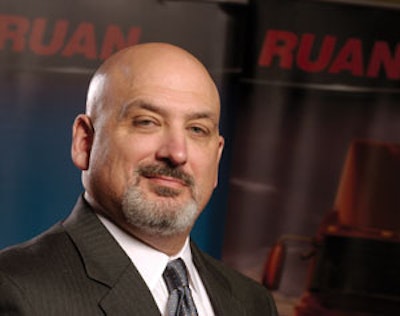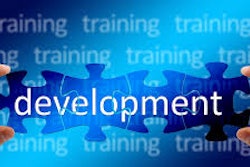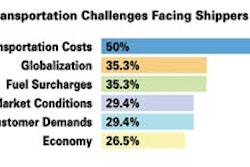
Political elites across the developed world are struggling with how best to deal with aging populations, even as business executives face the departure of some of their best leaders and a wealth of intellectual capital with the retirement of the Baby Boomers. But while public- and private-sector leaders debate the best responses to these demographic changes, smart companies are putting in place programs to ensure they are able to maintain, and build on, their own leadership cadres. And, in doing so, these forward-looking enterprises are helping to build the next generation of supply chain leaders.
At Des Moines, Iowa-based Ruan Transport Corp., for example, the company has strategically refocused its recruitment and training program in the face of the retirement of a large percentage of its current employee base, many of whom hold management leadership roles. To support the company's five-year growth objectives, Ruan's management training program works to clearly identify individuals both within and outside the company who, with the right training and support, can become strong company leaders.
Riding the Wave
Ruan Transport Corp. is a privately held provider of dedicated contract carriage, bulk transportation Ruan Certified Brokerage services and integrated services including logistics, warehouse management and cross-docking among others. The company, founded in 1932 at the height of the Depression, has grown to encompass more than 5,500 employees at 162 locations. Boasting a driver turnover rate that is one-fifth industry average, the company is known for, among other things, hauling about 80 percent of the milk in California and about 17 percent nationwide.
Jim Mulvenna, vice president of safety and administration at Ruan, notes that the demographic wave generated by the start of the retirement of the 78 million Baby Boomers in 2005 is affecting his company as much as any other organization in the industry. However, Mulvenna says that Ruan is framing the challenge presented by this demographic tsunami in terms of the relationship between leadership and growth potential at the company.
Mulvenna notes that Ruan has maintained customer retention rates in the high nineties even as it has grown through a series of acquisitions, and it views customer service as one of its competitive advantages in the marketplace. The key to maintaining that advantage and continuing to grow, as Ruan sees it, is preserving a high degree of exceptional leadership from the terminal level on up within the company's organization. "We're a very decentralized company," Mulvenna explains, "with each of our locations nationwide operating as an independent business unit. The individuals out there in the field are our first level of leaders dealing directly with the customers on a daily basis. We're only going to be able to grow as fast as we can bring quality leadership into the company to maintain our high level of customer service. But with the aging population there will be fewer leaders available in the workforce."
To tackle this challenge, over the past three years Ruan has put in place a two-pronged strategy comprised of an internally focused management succession plan and the company's externally directed recruiting efforts. For the former, Ruan looks to identify future potential senior managers and bring them up through the ranks using management training courses and a mentoring program that pairs senior leaders from among the company's terminal managers with the next generation of operational executives. The mentoring program is based on the principle that leaders can only be developed by other leaders, and it serves a dual purpose: It exposes participants to the key initial rung of senior management within the company, but it also helps Ruan to develop leadership qualities among the managers themselves. "The mentoring program is a tremendous development and training tool for the terminal managers," Mulvenna says. "It really helps them sharpen their skills, and it helps us to identify any gaps in their leadership competencies."
The recruitment program, which Mulvenna runs — and funds — through the training department that he heads, aims to bring in about 15 new employees each year and put them on a management track. Ruan derived its target recruiting numbers from an analysis of the company's projected growth and the attrition rate within its own workforce. In addition, the company wanted to limit the number of candidates brought into the program both to ensure the high quality of the candidates but also to ensure that it would have positions in which to place the recruits as they complete their training. "If you develop too many leaders and don't have opportunities to keep in front of them, they're going to leave you," Mulvenna notes. "We're really looking to develop long-term relationships with these folks."
Looking for Leaders
Ruan focuses its recruiting efforts on drawing in students from colleges and graduate school programs, bringing in former military personnel, and attracting transportation industry veterans. Mulvenna looks to recruit students out of the transportation and logistics programs at such universities as Iowa State, Northwestern and Arizona State, although he also considers graduates of general business programs at schools like the University of Iowa. His philosophy, shaped by his own 25 years serving in the U.S. Army as a combat arms officer, is to look, first, for candidates that have exhibited leadership potential, possibly through participation in extracurricular activities such as student government or athletics.
On the military side, Mulvenna leverages his service background and looks for candidates with logistics or transportation experience, but, again, he also pays attention to the types of responsibilities that they assumed in their military career. "I can analyze very quickly, given my experience, whether or not they had actual leadership experience that rises to the level that I'm interested in," Mulvenna says. Finally, Ruan looks at candidates from the industry, including both professionals who have worked in the transportation sector, as well as those who have done stints within the different industry verticals that Ruan serves such as retail, steel and grocery. "We have such a large diversity in our customer base," Mulvenna notes, "that sometimes folks from those customer sectors are a good fit for us."
The recruits accepted into the program go into a four- to six-month onsite training period at a local terminal operation with the goal of becoming a terminal manager. The program is largely task-based; participants have a critical task list comprised of the key skills and jobs that a terminal manager must understand to be effective. The list starts with the driver's duties, and candidates do ride-alongs to understand how Ruan's drivers perform their duties on a daily basis, how they interact with customers, fill out their logs, do their pre- and post-checks for maintenance, buy their fuel and so on. Then the recruits progress up through the dispatch or transportation supervisor function, regarded as the first line of leadership within the company, before learning how the terminal manager ties the operations together. "The terminal manager really hits the foundation of skills that we require: customer service, leadership, taking care of your people, the financial aspects, and the safety and maintenance aspects," Mulvenna says.
In addition to the field training, the recruits also go through a three-week classroom training curriculum that covers the various basic business aspects of Ruan's operations. Run on a quarterly basis in Des Moines, the curriculum is comprised of a one-week leadership and management course to give the students a broader perspective on Ruan's business; a course on effective communication that covers presentation skills and business communications; and a two-day leadership problem-solving and decision-making seminar aimed at helping the recruits understand Ruan's strategic goals and how their own activities align and support those goals. "We're focusing on getting everyone in the company to understand how they contribute to the larger picture," Mulvenna explains. "Because the challenge in any organization is to synchronize the strategic plan all the way to the individuals who are executing it, and for us that means the drivers."
Although Mulvenna heads up the program, he coordinates closely with Ruan's regional vice presidents on recruitment and training. In fact, candidates go through a two-phase interview process, first with Mulvenna, who identifies the talent and does the initial screening, and then a follow-up interview in Des Moines with an operational vice president. The choice of which candidate is placed in which terminal is then coordinated with the regional vice presidents, who are responsible for between five and 15 terminals. "The regional vice presidents are responsible for business development within their regions in conjunction with the sales force," Mulvenna notes. "But they also interact with their terminal managers to lead them and mentor them, and they're going to guide them through those first critical years within our organization. So they have to embrace this program in order for it to be successful."
That being said, the recruits remain on the training budget until they receive their assignment as a terminal manager. Mulvenna says that this arrangement allows him to have a greater degree of management over the recruits' release into the field, since some may take as long as six months to get trained, while others may complete their critical task list within four months. "We don't want to put them into a situation that they might not be ready for," Mulvenna explains. "We want to set them up for success."
20-70-10
The gauge of the long-term success of Ruan's recruitment and training is the company's own performance over time, its ability to grow the business while maintaining customer service levels, and both customer and employee retention rates. Mulvenna has been running the program for only about three years, but he says that he has seen at least anecdotal evidence that it is paying off in the form of positive feedback from customers that have been impressed with the quality and competency of the recruits that have gone through the program. In addition, the program has helped Ruan to build a network of management-level interconnections throughout the company as mentors and mentored recruits move across and up through the company, helping to tie the organization more closely together as an enterprise. And regional vice presidents have been able to tap into the pool of recruited talent to assume management positions within businesses that Ruan has acquired, helping to spread Ruan's culture to these organizations more quickly than might otherwise have been possible.
In summarizing the impact of the program, Mulvenna refers to Jack Welch's 20-70-10 maxim — that 20 percent of your staff are likely to be the future leaders of the organization, 70 percent are the necessary employees who make the machine run, and 10 percent need to be "managed out" of the business. The program at Ruan is aimed at cultivating the 20 percent and growing it over time, with a focus, first and foremost, on recognizing and nurturing leadership. "My perspective, coming out of the military, is that leadership is what makes things happen," Mulvenna concludes. "There's equipment and competent people that understand how to make that equipment work, but all of that requires the oversight of competent leaders who can bring it all together."
















